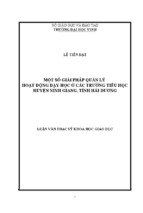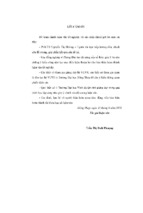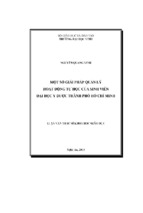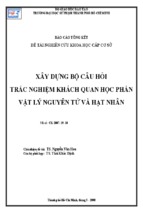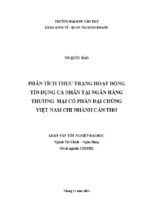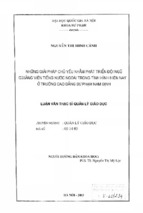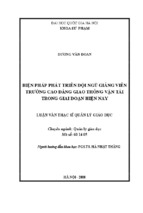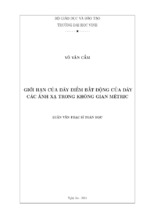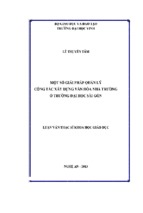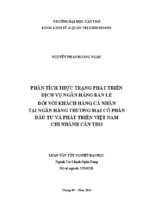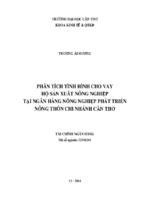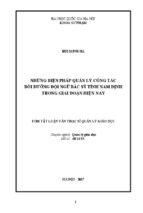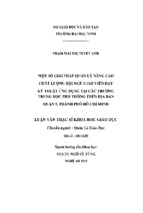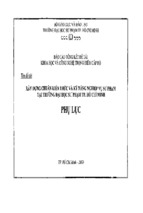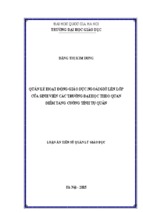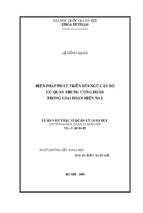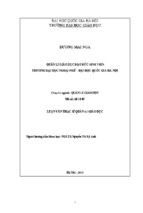VIETNAM NATIONAL UNIVERSITY, HANOI
UNIVERSITY OF LANGUAGES AND INTERNATIONAL STUDIES
FACULTY OF POST- GRADUATE STUDIES
-------------------
VÕ THỊ NGỌC HÂN
AN INVESTIGATION INTO LISTENING STRATEGY INSTRUCTIONS
AND APPLICATIONS IN A PRIVATE EFL SCHOOL IN VIETNAM
NGHIÊN CỨU VỀ VIỆC HƯỚNG DẪN VÀ ÁP DỤNG CHIẾN LƯỢC NGHE TẠI MỘT
TRUNG TÂM ANH NGỮ Ở VIỆT NAM
M.A. MINOR THESIS
Field: English Teaching Methodology
Code: 60140111
Hanoi, 2014
VIETNAM NATIONAL UNIVERSITY, HANOI
UNIVERSITY OF LANGUAGES AND INTERNATIONAL STUDIES
FACULTY OF POST- GRADUATE STUDIES
-------------------
VÕ THỊ NGỌC HÂN
AN INVESTIGATION INTO LISTENING STRATEGY INSTRUCTIONS
AND APPLICATIONS IN A PRIVATE EFL SCHOOL IN VIETNAM
NGHIÊN CỨU VỀ VIỆC HƯỚNG DẪN VÀ ÁP DỤNG CHIẾN LƯỢC NGHE TẠI MỘT
TRUNG TÂM ANH NGỮ Ở VIỆT NAM
M.A. MINOR PROGRAMME THESIS
Field: English Teaching Methodology
Code: 60140111
Supervisor: Dr. Nguyễn Trường Sa
Hanoi, 2014
SUPERVISOR’S REMARKS
...........................................................................................................................................
...........................................................................................................................................
...........................................................................................................................................
...........................................................................................................................................
...........................................................................................................................................
...........................................................................................................................................
...........................................................................................................................................
...........................................................................................................................................
...........................................................................................................................................
...........................................................................................................................................
...........................................................................................................................................
...........................................................................................................................................
...........................................................................................................................................
...........................................................................................................................................
...........................................................................................................................................
...........................................................................................................................................
...........................................................................................................................................
...........................................................................................................................................
i
JUDGEMENT OF THE EVALUATION BOARD
...........................................................................................................................................
...........................................................................................................................................
...........................................................................................................................................
...........................................................................................................................................
...........................................................................................................................................
...........................................................................................................................................
...........................................................................................................................................
...........................................................................................................................................
...........................................................................................................................................
...........................................................................................................................................
...........................................................................................................................................
...........................................................................................................................................
...........................................................................................................................................
...........................................................................................................................................
...........................................................................................................................................
ii
ACKNOWLEDMENTS
First of all, I would like to send my gratefulness to the board of University of
Languages and International Studies - Vietnam National University, Hanoi for their
allowance for me to carry out the research.
The thesis is especially dedicated to Mr. Nguyen Truong Sa; my experienced
instructor, whose passionate enthusiasm and precise guidance have come along my
journey to fulfill this assignment on schedule.
It will be indispensable for me to take into account the contribution I have received
from Europe-Vietnam Language School. All of the school‟s staff has provided me
with the best assistance in terms of comprehensive knowledge and relevant materials.
Finally, I send my best to the six teachers and twelve learners who help me to justify
the data. Without their contribution, my thesis would not be completed.
iii
DECLARATION OF AUTHORITY
I, Vo Thi Ngoc Han, declare that this graduation thesis is original and has not been
submitted for assessment elsewhere.
I declare that this thesis is my own work and does not involve plagiarism or collusion.
I give my consent to electric version to be examined by relevant plagiarism software
programs.
I have made a copy or electronic copy of my assignment, which I can produce if the
original is lost for any reason.
Date:……/……/……
Vo Thi Ngoc Han
iv
ABSTRACT
Derived from the nature of listening strategies, unconscious activities of learners but
conscious of teachers, in combination with the researcher‟s challenges in teaching listening,
the research is implemented to investigate listening strategy instructions and applications.
Research question that decides content of the research is how listening strategies are
instructed and applied in EFL class. It was carried out in Europe-Vietnam Language School
where learners are motivated by their apparent learning purposes. Six participants contain
three EFL teachers and three EFL students from the teachers‟ classes. Two instruments used
were observation and stimulated recall. As a result, despite teachers‟ different preferences of
using strategies, learners only get familiar with cognitive and social-affective strategies. Their
weaknesses found were their inability in controlling listening processes, problems in
pronunciation, and difficulties in building up learning spirit due to their passive learning style.
With the investigation into the reality of using listening strategies, the research is in
the hope to help teachers and learners remedy their current strategy use with the help
of their private school.
v
TABLE OF CONTENTS
SUPERVISOR‟S REMARK
i
JUDGEMENT OF THE EVALUATION BOARD
ii
ACKNOWLEDGEMENTS
iii
DECLARATION
iv
ABSTRACT
v
TABLE OF CONTENTS
vi
LIST OF ABBREVIATIONS
ix
TRANSCRIPTIONS OF CONVENTIONS .................................................................... x
PART A: INTRODUCTION
1
1. Research background and problem ............................................................................... 1
2. Research aims/ objectives ............................................................................................. 2
3. Research questions ....................................................................................................... 2
4. Context of the study ...................................................................................................... 3
5. Importance/ value of the study ..................................................................................... 4
6. Definitions of some key terms ...................................................................................... 4
PART B: DEVELOPMENT ............................................................................................. 6
CHAPTER 1: LITERATURE REVIEW
6
1.1. Listening comprehension .............................................................................................. 6
1.1.1. The nature of listening ................................................................................. 6
1.1.2. Significance of listening .............................................................................. 7
1.1.3. Difficulties in listening comprehension .................................................... 7
1.2.
1.1.3.1. Problems with spoken language ...................................................... 8
1.1.3.2. Problems in dealing with sounds ...................................................... 9
1.1.3.3. Problems with background knowledge ............................................. 9
1.1.3.4. Problems with mood ...................................................................... 10
Listening strategies .............................................................................................. 10
1.2.1. Nature of strategies ................................................................................... 10
vi
1.3.
1.2.2. Categories of listening strategies .............................................................. 11
1.2.2.1. Metacognitive listening strategies .............................................. 11
1.2.2.2. Cognitive listening strategies ...................................................... 12
1.2.2.3. Social affective strategies ........................................................... 13
Teachers‟ roles in listening .................................................................................. 13
1.3.1. Why listening strategies are taught in the context of classroom ............. 13
1.3.2. What a teacher does in a listening class .................................................. 14
1.4.
A review of previous researches on teaching/applying listening strategy .......... 15
CHAPTER 2: METHODOLOGY OF THE RESEARCH
17
2.1. Instruments ................................................................................................................ 17
2.1.1. Observation ................................................................................................... 17
2.1.2. Think aloud/ Stimulated recall ............................................................................. 18
2.2. Participants ................................................................................................................ 18
2.2.1. The teachers ................................................................................................. 19
2.2.1.1. Teacher 1 ...................................................................................... 19
2.2.1.2. Teacher 2 ................................................................................... 19
2.2.1.3. Teacher 3 ....................................................................................... 20
2.2.2. The learners ................................................................................................ 20
2.2.2.1. Learner 1 ....................................................................................... 20
2.2.2.2. Learner 2 ...................................................................................... 21
2.2.2.3. Learner 3 ....................................................................................... 21
2.3. Data collection procedure ........................................................................................... 21
2.4. How to use the data to answer the research questions ............................................... 22
CHAPTER 3: RESULTS AND DISCUSSIONS
23
3.1. Teachers‟ strategy instructions when teaching listening ........................................... 23
3.1.1. Teacher 1‟s (T1‟s) ....................................................................................... 23
3.1.2. Teacher 2‟s (T2‟s) ....................................................................................... 24
3.1.3. Teacher 3‟s (T3‟s) ....................................................................................... 25
3.1.4. Summary of the three teachers‟ listening strategy instructions ................... 27
3.2. Learners‟ strategy applications when learning listening ............................................ 27
3.2.1. Learner 1‟s (L1‟s, in T1‟s upper-intermediate class) ................................. 27
vii
3.2.2. Learner 2‟s (L2‟s, in T2‟s primary class) ................................................... 28
3.2.3. Learner 3‟s (L3‟s, inT3‟s intermediate class) ............................................. 29
3.2.4. Summarize of learners ................................................................................ 30
3.3. Teachers‟ and learners‟ problems ............................................................................. 30
PART C: CONCLUSION AND IMPLICATIONS
32
1. Introduction of this chapter ........................................................................................... 32
2. Implication of the study to practice ............................................................................... 32
3. Limitation and suggestion for future research .............................................................. 33
4. Final consideration ........................................................................................................ 34
REFERENCES
35
APPENDIX 1 ...................................................................................................................... I
APPENDIX 2 ..................................................................................................................... II
APPENDIX 3 ................................................................................................................ VIII
SUMMARY OF THE RESEARCH ......................................................................... XXV
viii
LIST OF TABLES
Table 1: Top 10 listening problems ............................................................................. 8
Table 2: Data collection procedure ............................................................................ 22
ix
TRANSCRIPTIONS OF CONVENTIONS
R: Researcher
L1: Learner 1
L2: Learner 2
L3: Learner 3
T1: Teacher 1
T2: Teacher 2
T3: Teacher 3
[ ...]: [text translated from Vietnamese into English]
T (L)…/ Sti/ …/ …: Teacher (Learner)/ Stimulated recall/ date/ month.
x
PART A
INTRODUCTION
1.
Research background and problem
In Vietnam, since Doi Moi policy, English is chosen to be the foreign language taught
and used in Vietnam (Alter & Moreau, 1995). Goh and Nguyen (2004) pointed out that
“the learning of English in the schools gained in popularity” and “English quickly
became the first foreign language” (p. 30). Do (2006) concluded that in the decade of
1996-2006, English had been developed with an incredible speed in Vietnam. In the
context of globalization, teaching and learning English in Vietnam is a pivotal matter.
Ho Chi Minh City is the largest city of Vietnam with the most crowded population.
Requirements of English knowledge for economic development of the city are
inevitable. Therefore, Ho Chi Minh City has the biggest number of teachers and
learners all over the country (Do, 2006). Vu (2007) pointed out that HCMC has
become home to the strongest movement towards learning English with the largest
number of student learning and taking English examinations in Vietnam.
Previous studies on listening strategies mainly used the context of state schools where
students are at the same age and have the same learning goal (Thompson and Rubin,
1996; Yu-mei & Lei, 2012; Siegel, 2013; Goh, 2000). However, Do (2006)
emphasized that “hundreds of English centers have been established everywhere – Ho
Chi Minh City alone has around 300 language centers” (p.8). The centers are
attracting learners of different backgrounds aiming to secure a bright future of work by
enriching English. In this research, private school is an environment to investigate. It is
a different context where learning goal is, in most of cases, not for testing but to
improve English competence. Learners in private schools come from different
1
backgrounds, possess various foundations of English, hold a variety of learning
purposes, and perform diverse attitudes as well as learning styles. More important, it is
teachers‟ job to satisfy each learner‟s needs and goals.
In teaching and learning English for communicative purpose, listening is emphasized.
It is considered the most vital in oral interaction, as Richards and Renadya (2002)
emphasized, “without understanding input at the right level, any learning simply
cannot begin, listening is thus fundamental to speaking” (p.239). To be good at the
skill, the concept of “listening strategies”- way to facilitate listening learning – is
discussed. A question raised is that whether listening strategies are “conscious” or
unconscious” (Ridgway, 2000). Teachers‟ role is to instruct learners how to use the
listening strategies consciously, because as Oxford (1990) pointed out, “if strategies
are unconsciously and automatically used, then explicit strategy training makes little
or no sense, so it involves some degrees of conscious awareness on the part of the
learner.” (p2). However, to learners, when learning process happens continuously,
they do not have time to choose which strategies to employ. Therefore, strategies
become autonomous and unconscious. If strategies are unconscious for students, have
they been using them effectively? After a long period of time working at some
different private schools, the researcher finds that a large number of learners in the
private classes still fail to gain success in listening. Therefore, the researcher wonders
what problems are obstructing the teaching and learning process. In other words, it is
necessary to investigate whether listening strategies is instructed and applied
appropriately.
2.
Research aims/ objectives
This research is carried out to meet its practical purpose. From the failure of EFL
learners in listening, the researcher wonders what problems are obstructing the
2
teaching and learning process. In other words, it is necessary to investigate whether
listening strategies is instructed and applied appropriately. At first, teachers‟ strategy
instructions in the context of classroom are manifested. Secondly, under the directions,
learners‟ strategy applications are analyzed. Finally, challenges that affect listening
teaching and learning results are also revealed for later surmount.
3.
Research questions
The general question addressed in this study is: How are listening strategies instructed
and applied in EFL class?
This question can be answered by addressing these specific questions:
1.
How do teachers instruct listening strategies when teaching?
2.
How do learners apply listening strategies into their practice in their class?
3.
What are the challenges in teaching and applying listening strategies?
4.
Context of the study
Context chosen in the research is a private English school, Vietnam- Europe
International School. The school is located in district 12 of Ho Chi Minh City with one
head office at 114 Nguyen Anh Thu street, Trung My Tay ward, district 12 and one
branch at 5C, To Ky street, Tan Chanh Hiep ward, district 12. Established in 2010,
with the increase of English demand, the private school has continuously developed.
The private English school possesses a system of teachers including English experts
from Melbourne University of Australia, Foreign teachers and Vietnamese teachers.
Until April of 2014, the school has possessed forty five teachers and more than one
thousand four hundred learners. Aiming at the main objects as students in The
University of Labor and Social Affair (ULSA), the English school has been
3
developing three main curriculums; communication, TOEIC (Test of English for
International Communication), and IELTS (International English Language Testing
System). Especially, communication program is boosted to meet the need of the
majority of English learners.
Communication course was chosen for the purpose of this research based on three
main criteria. At first, the program requires listening as a major skill. If learners do not
use suitable strategies, such as predicting, inferring, recognizing cognates and so on,
they will fail to meet listening goals. Next, tasks are composed basing on different
contexts, it is significant for students to equip their background knowledge about the
contexts and corresponding strategies. Last but not least, without listening, any oral
communication cannot be implemented.
With the hope of releasing the most objective and reliable results, the researcher chose
this program to investigate the thesis issue. The context meets the need of the thesis, a
private English school teaching communicative listening with the program requires
applications and instructions in strategies.
5.
Importance/ value of the study
This research will be carried out to meet its practical purpose. It will hopefully take
attention of EFL teachers and learners who concerns about improving listening
strategies. The research is expected to assist teachers in bewaring of how their learners
are dealing with the instructed strategies. Then it finds out effective ways to instruct
strategies to learners. On the aspect of learners, the results will help them pay more
attention to listening strategies and make use of the strategies more effectively.
Finally, the study‟s result is intended to help administrators of private English schools
in Vietnam enhance their quality of listening education so that they can serve their
learners better.
4
6.
Definitions of some key terms
Listening comprehension
“Listening comprehension is an active process of constructing meaning, and that this
is done by applying knowledge to the incoming.” (Buck, 2000, 30)
Strategies
Language learning strategies are “approaches or techniques that learners use to
enhance their progress in developing L2 skills” (Oxford, 1990, 22). They are
considered “conscious” for teachers to instruct and “unconscious” or “autonomous”
for learner to use frequently because there is no time for learners to employ them in
actual situation.
Cognitive strategies: the strategies relate directly with processes of listening, in other
words, steps of acquiring listening knowledge for reasoning, analyzing, summarizing,
and practicing a listening task (Anderson, 1991).
Metacognitive strategies for evaluating one‟s progress, planning for language tasks,
consciously searching for practice opportunities, paying attention, and monitoring
errors. It is the biggest term that controls other strategies (Efteckhary & Gharib, 2013).
Social affective strategies: the techniques listeners used to interact, collaborate with
others, such as teachers, speakers, or peers to clarify understanding or to lessen their
stress during listening (Vandergrift, 2003).
5
PART B: DEVELOPMENT
CHAPTER 1
LITEARATURE REVIEW
1.1. Listening comprehension
1.1.1. The nature of listening
In common sense, listening comprehension is passive and simple (Thompson & Rubin,
1996; Jung, 2003; Vandergrift, 2004; Rahimi, 2012). On one hand, listening seems
passive as it is uncreative and unimaginative when listeners receive speakers‟
information. Speakers, not listeners, control over speed, structure and meaning of a
talk (Ridgway, 2000). On another hand, it is thought to as simple because it does not
require any production, with good knowledge, learners can be a good listeners
(Rahimi, 2012). However, researchers defeated the sense by their arguments.
At first, researchers, such as Buck (2000), Underwood (1989), and Vandergrift (1999),
defeated the term “passive”; they proved that listening had to be „active‟. Underwood
(1989) used the adjective “passive” to indicate “hearing” instead of “listening”.
Vandergrift‟s study (1999) affirmed that listeners could not be passive because during
listening, they did not merely receive speakers‟ sound but also had to make clear the
differences among elements of utterances, such as sounds, vocabulary, grammar,
pronunciation, and prior knowledge as well as what inputted into their mind. Buck
(2000) proved, “listening comprehension is an active process of constructing meaning,
and that this is done by applying knowledge to the incoming” (p.30).
Listening, in addition, is a complicated process requiring people‟s serious
concentration and profound knowledge. According to Brody (2004), focusing is never
6
enough for a good listener. The complicated nature of listening is also revealed by
language components, such as phonology, syntax, semantics, as well as knowledge of
context, which must be done simultaneously (Pearson, 1983 cited in Butt et al., 2010).
From the definitions of listening, a conclusion of the skill is drawn. It is not simple to
deal with and the level of success in the skill requires numerous factors of an active
learning process. Nevertheless, why must learners attempt to be good at the
complicated and active process? The reasons will be discussed in the following part.
1.1.2. Significance of listening
In Rahimi‟s research (2012), listening in this modern era is regarded a significant goal
in numerous teaching curricular of a language. Richards (1999, 200) concluded in his
research, “second language acquisition researches have given a major boost to
listening.” According to Brown (2001), listening is an important skill through which
language learners input linguistic information, or material, in order to produce
language. In daily communication, speaking is necessary, but listening is inevitable to
maintain a conversation. Misunderstanding or lack of understanding will lead to failure
in every dialogue. An oral interaction can never be implemented without listening.
Moreover, Vandergrift (1999) noted that “listening comprehension plays a key role in
facilitating language learning” (p.168). Good listening competence provides learners
with knowledge, confidence, and motivation of language learning (Rost, 2002a). In
brief, the significance of listening is revealed by its frequent use in daily life, leading
role in communication, and the role as a source of mental benefits including
knowledge, confidence, and motivation. Thanks to its importance, the need to achieve
it is vital. However, the decisive oral skill is evaluated complicated. The next part will
discuss troubles in its applications that listeners have to overcome.
7
1.1.3.
Difficulties in listening comprehension
As the importance of listening skill discussed, the demand to master it is necessary.
However, due to its complicated nature, its success seems to be a challenge. According
to Siegel (2013), listening has been considered the most awkward of the four macro
skills. The difficulties of listening derive from the following sources.
Number
Sources of listening problems
%
1
Speaking rate
100
2
Distraction
95
3
Unable to recognize words they knew
90
4
New vocabulary
85
5
Missing subsequent input
80
6
Nervousness
70
7
Sentence complexity
60
8
Background knowledge
55
9
Anxiety and frustration
45
10
Unfamiliar pronunciation beside what they 40
usually listen to
Table 1: Top ten listening problems (Renandya & Farrell; 2010, 54)
From the above problems, I sort them into four main groups; group of numbers 1, 2,
and 5 belongs to problems with spoken language, group of number 3 and 10 is
8
- Xem thêm -


